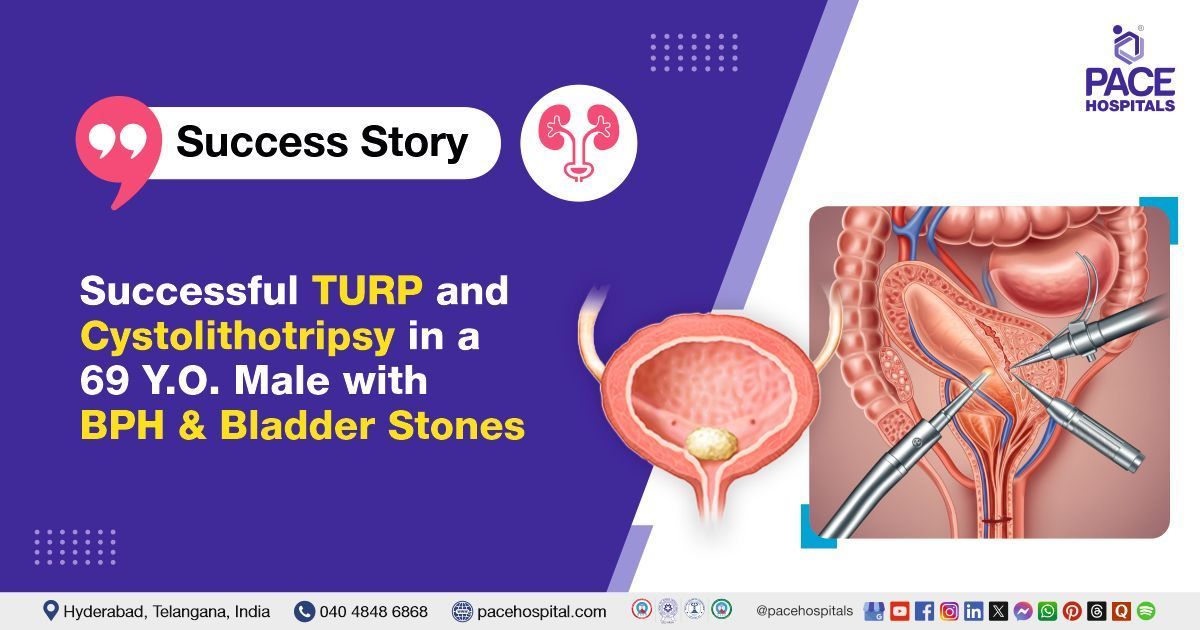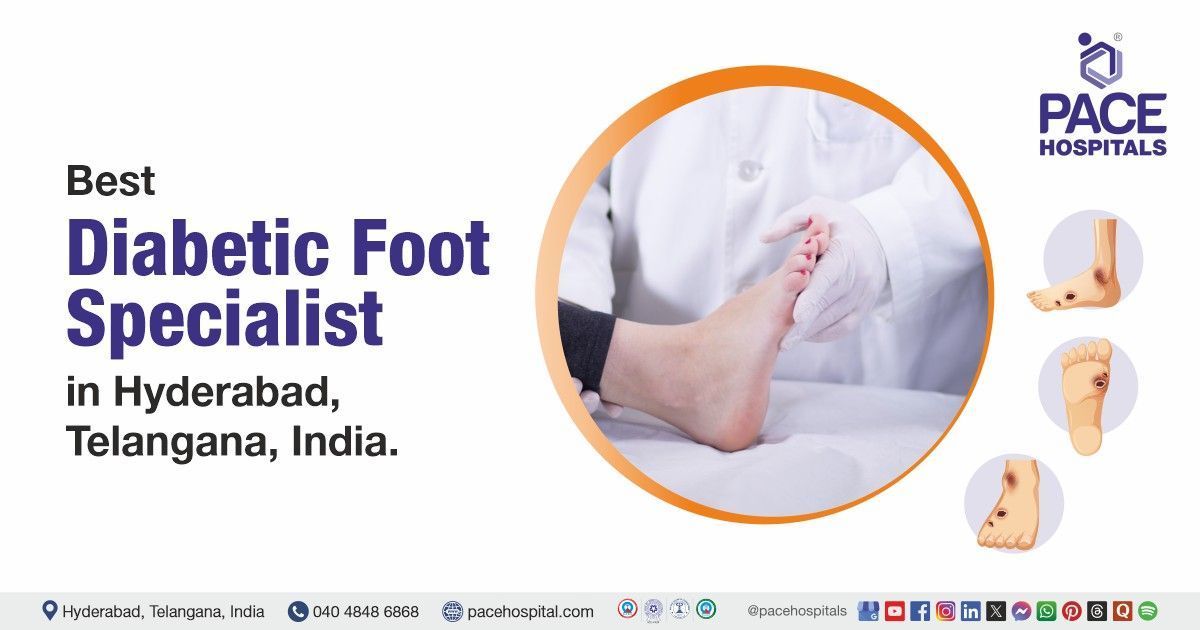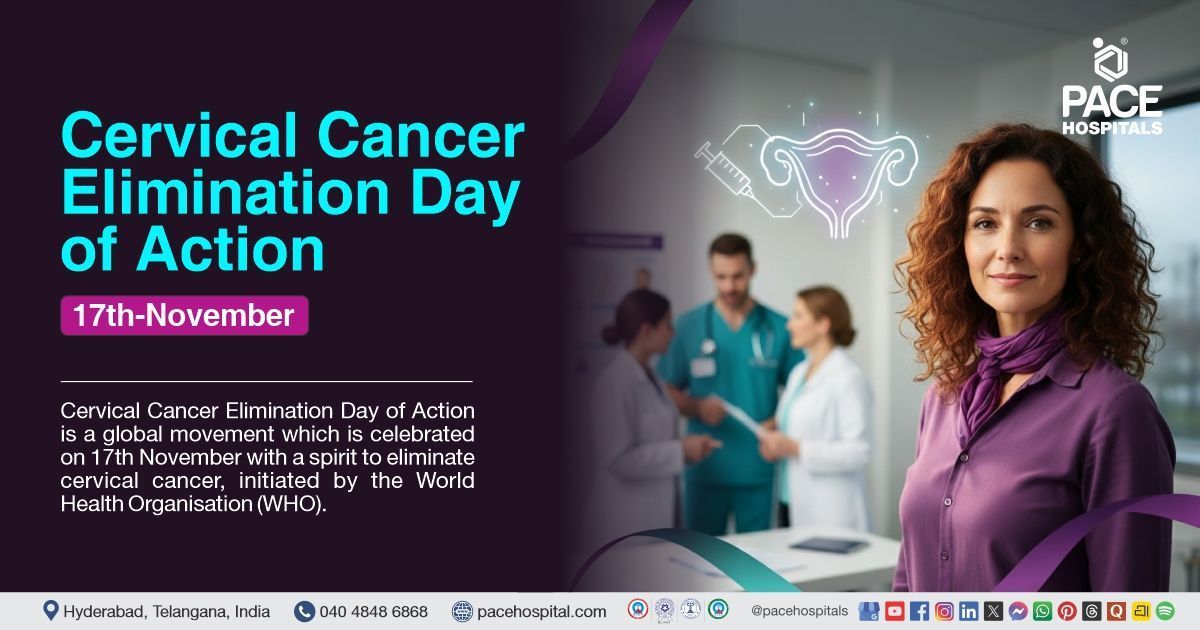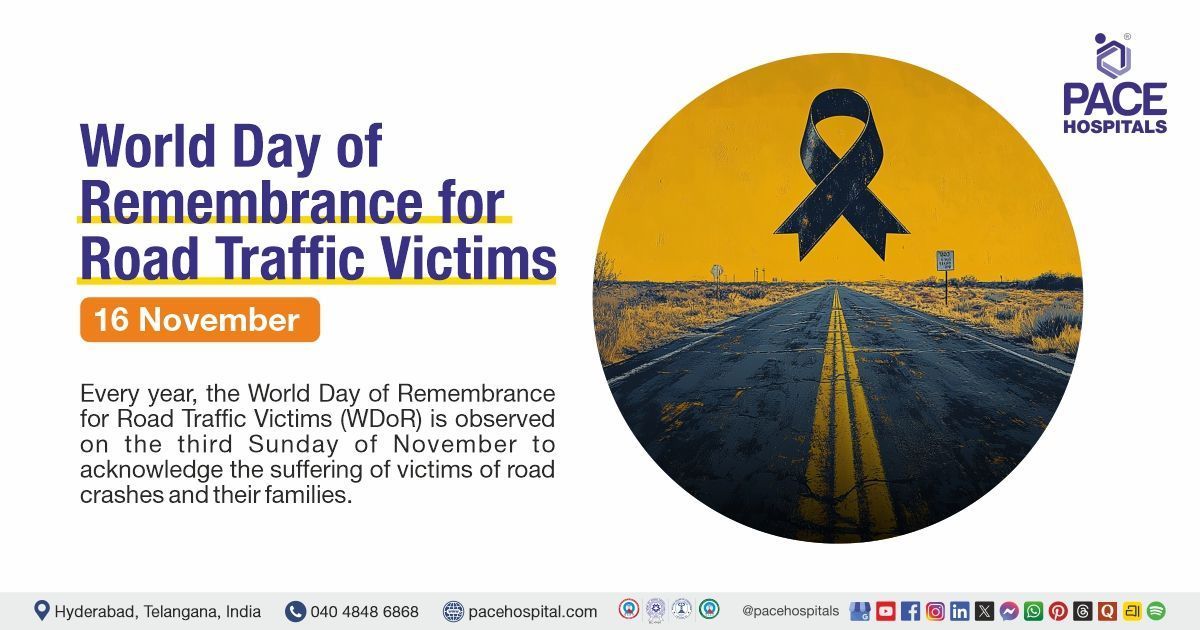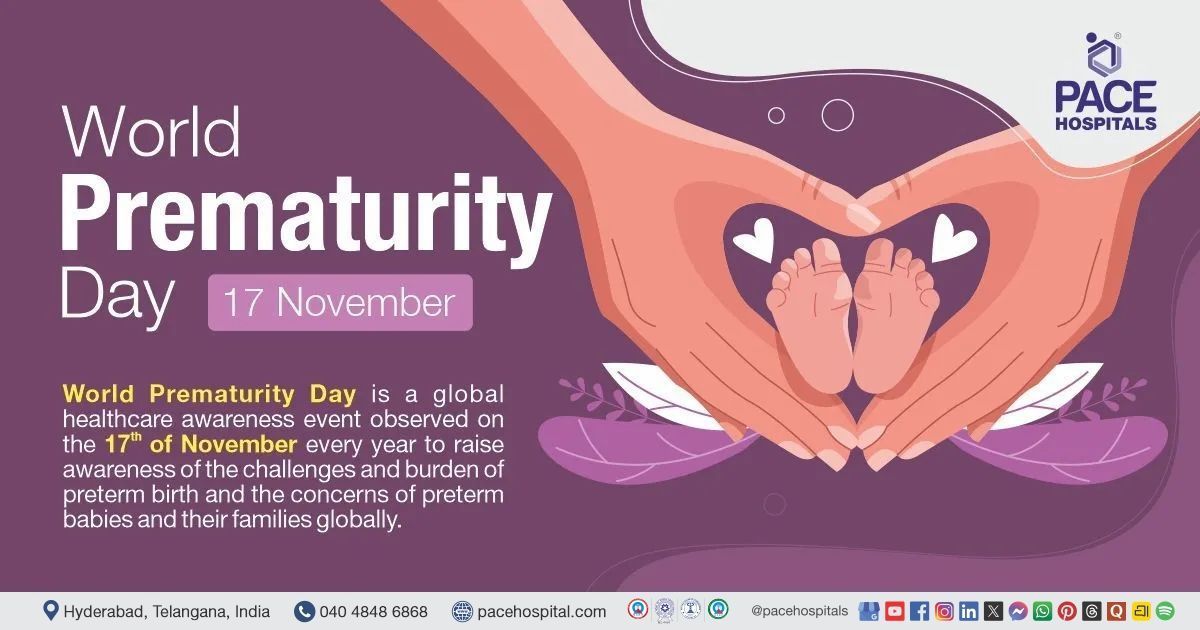Successful TURP and Cystolithotripsy in a 69-Year-Old Male with BPH & Bladder Stones
PACE Hospitals
The PACE Hospital's expert Urology team successfully performed a Transurethral Resection of the Prostate (TURP) along with Cystolithotripsy on a 69-year-old male patient who presented with poor urinary flow, hesitancy (delay in initiating urination), dysuria, and increased frequency of urination. The procedures were performed to relieve bladder outlet obstruction caused by an enlarged prostate and to remove bladder stones, thereby improving the patient's urinary function and overall quality of life.
Chief Complaints
A 69 -years- old male patient with a
Body Mass Index (BMI) of 23 presented to the Urology Department at
PACE Hospitals, Hitech City, Hyderabad, with the complaints of poor urine flow, hesitancy (delay in initiating urination), dysuria, and increased urinary frequency. These symptoms are suggestive of underlying lower urinary tract issues, commonly associated with benign prostatic hyperplasia or other causes of bladder outlet obstruction, and require further evaluation and management.
Medical History
The patient had no history of diabetes, hypertension, chronic kidney disease, or other significant comorbidities. His overall health status was stable, enabling focused assessment and management of his current urinary symptoms.
On Examination
On examination, the patient was conscious and oriented, with stable vital signs. Abdominal examination revealed no distension, tenderness, or palpable masses, and there was no evidence of bladder fullness or discomfort. A digital rectal examination (DRE) revealed a moderately enlarged, smooth, and non-tender prostate, suggestive of benign prostatic hyperplasia (BPH). There were no signs of acute urinary retention, and the external genitalia appeared normal with no visible lesions or abnormalities.
Systemic examination, including cardiovascular, respiratory, and neurological assessments, showed no abnormalities, indicating that the urinary symptoms were localized without systemic involvement.
Diagnosis
The patient initially underwent a comprehensive clinical assessment at PACE Hospitals, including a detailed history and physical examination by the Urology team. During the evaluation, a series of diagnostic tests were performed.
A urine culture was performed, which was positive, confirming a urinary tract infection (UTI). To obtain more detailed imaging, a non-contrast CT KUB (Kidneys, Ureters, and Bladder) scan was conducted, which confirmed the presence of two large vesical (bladder) calculi measuring 18 × 14 mm each, as well as small bilateral renal calculi. An ultrasound of the abdomen and pelvis supported these findings, showing the enlarged prostate and renal stones. Blood tests, including complete blood count and renal function tests, were performed and found to be within normal limits.
During the evaluation, the patient was diagnosed with benign prostatic enlargement with lower urinary tract symptoms, large bladder calculi, and small bilateral renal calculi, along with a urinary tract infection. These findings necessitated surgical intervention with cystolithotripsy and transurethral resection of the prostate (TURP).
Based on the confirmed findings, the patient was advised to undergo
Bladder Stones and
Enlarged Prostate Treatment in Hyderabad, India, under the expert care of the Urology Department.
Medical Decision Making
Following a detailed consultation with Dr. Abhik Debnath, Consultant Laparoscopic Urologist, a comprehensive evaluation of the patient’s condition was undertaken. Considering his symptoms of poor urine flow, hesitancy, dysuria, and frequency, along with imaging findings of large bladder stones and small bilateral kidney stones, the urology team determined that transurethral resection of the prostate (TURP) combined with cystolithotripsy would be the most suitable and effective intervention. Additionally, the presence of a urinary tract infection was managed with appropriate antibiotic therapy prior to surgery to reduce the risk of complications.
The patient and his family were thoroughly counselled regarding the severity of the condition, the details of the surgical procedure, potential risks, and the necessity of the procedure to restore function and promote optimal recovery.
Surgical Procedure
Following the decision, the patient was scheduled to undergo Transurethral Resection of the Prostate (TURP) and cystolithotripsy surgery in Hyderabad at PACE Hospitals, under the expert supervision of the Urology Department, ensuring optimal care and a smooth recovery process. The procedure was performed in the following steps:
1. Anesthesia and Initial Examination: The patient was placed under spinal anesthesia to ensure adequate pain control and muscle relaxation during the procedure. After appropriate positioning, cystoscopy was performed to visualize the bladder interior, where two large vesical calculi were identified.
2. Cystolithotripsy and Stone Removal: The two large bladder stones were carefully crushed using cystolithotripsy, a minimally invasive technique that breaks stones into smaller fragments. All stone fragments were then thoroughly removed to clear the bladder.
3. Prostate Assessment and Preparation: Following stone removal, the prostate was examined. It was found to be occlusive with a prominent, large median lobe, causing obstruction. The urethra appeared normal with no strictures or abnormalities.
4. Transurethral Resection of the Prostate (TURP): A standard monopolar TURP was performed to relieve the obstruction caused by the enlarged prostate. Amino acid was used as the irrigating fluid throughout the procedure to maintain clear visualization. Special care was taken to avoid injury to the prostatic capsule and adjacent structures. The resection lasted approximately 45 minutes, during which no perforation or venous sinus exposure occurred.
5. Postoperative Management: At the conclusion of the surgery, a suprapubic catheter (SPC) was placed to ensure adequate drainage of the bladder and prevent urinary retention. The patient was then monitored postoperatively for any complications.
Intra Operative Findings
The operation notes describe that the patient had a trabeculated bladder, which means the bladder’s muscle walls were thickened or scarred. The prostate was found to be irregular, with a large median lobe. Due to the irregular shape of the prostate and a borderline Prostate-Specific Antigen (PSA) level of 4.25 ng/ml, the medical team decided to take a prostate biopsy using TRUS (Transrectal Ultrasound) during the TURP procedure.
The biopsy involved removing 4 small tissue samples from the prostate to check for any abnormalities or signs of prostate cancer. This approach helps ensure a comprehensive diagnosis while addressing the patient's symptoms.
Postoperative Period
The intraoperative and postoperative course was uneventful. The bladder irrigation was discontinued on the first postoperative day, followed by removal of the suprapubic catheter (SPC). The per urethral Foley catheter was removed on postoperative day 2. During his hospital stay, the patient was treated with intravenous antibiotics to effectively manage the urinary tract infection and prevent postoperative complications. He was subsequently discharged in a stable condition.
Discharge Medications
Upon discharge, the patient was advised to take an oral antibiotic to treat and prevent infection. For pain management, a pain reliever was prescribed, followed by as-needed use thereafter. A laxative syrup was recommended at bedtime to prevent constipation. A proton pump inhibitor to reduce stomach acid was prescribed to protect the gastric lining. To manage prostate enlargement, a 5α-reductase inhibitor was advised. Additionally, a supplement containing antioxidants was recommended to support overall prostate health.
Advice on Discharge
The patient was advised to avoid weightlifting and forward bending to prevent strain. He was also instructed to avoid straining during bowel movements and to refrain from prolonged travel by bus, auto, or two-wheeler. The patient was informed that passing small stones in the urine is common. Mild flank or suprapubic discomfort, occasional small amounts of blood in the urine, cloudy urine, and mild burning sensations were explained as expected symptoms that typically resolve within 7 to 10 days. Regarding diet, the patient was advised to consume low-spice, homemade food to aid recovery.
Emergency Care
The patient was informed to contact the emergency ward at PACE Hospitals in case of any emergency or development of symptoms like fever, abdominal pain, or vomiting.
Review and Follow-up Notes
The patient was advised to return for a follow-up visit with a Urologist in Hyderabad at PACE Hospitals, after 2–3 weeks for stitch removal and biopsy evaluation. A subsequent follow-up was scheduled after 6 months, which would include an ultrasound of the abdomen, serum creatinine measurement, complete urine examination (CUE), and uroflowmetry for general assessment and monitoring of renal stones.
Conclusion
This case highlights the importance of a multidisciplinary approach in managing bladder calculi with benign prostatic enlargement. Timely surgical intervention combined with careful postoperative care and patient education contributed to a successful outcome and reduced the risk of complications and recurrence.
Integrated Approach to Managing Bladder Stones and Enlarged Prostate
Successful treatment of bladder calculi in the presence of benign prostatic enlargement requires a holistic and carefully planned approach led by the urologist. Through preoperative evaluation, including infection control and detailed imaging, and assessment of prostate size and bladder function, it is essential to guide the choice of surgical intervention such as TURP combined with cystolithotripsy.
Precision in surgical technique, with attention to preserving key anatomical structures, reduces the risk of complications. Postoperative care involving antibiotics, pain management, and catheter maintenance supports effective recovery. Long-term follow-up with imaging and renal function monitoring is vital to detect and manage residual stones and prevent recurrence. The urologist / urology doctor plays a critical role in patient education on diet, lifestyle modifications, and symptom awareness, which are fundamental to maintaining urinary tract health and ensuring optimal outcomes.
Share on
Request an appointment
Fill in the appointment form or call us instantly to book a confirmed appointment with our super specialist at 04048486868

